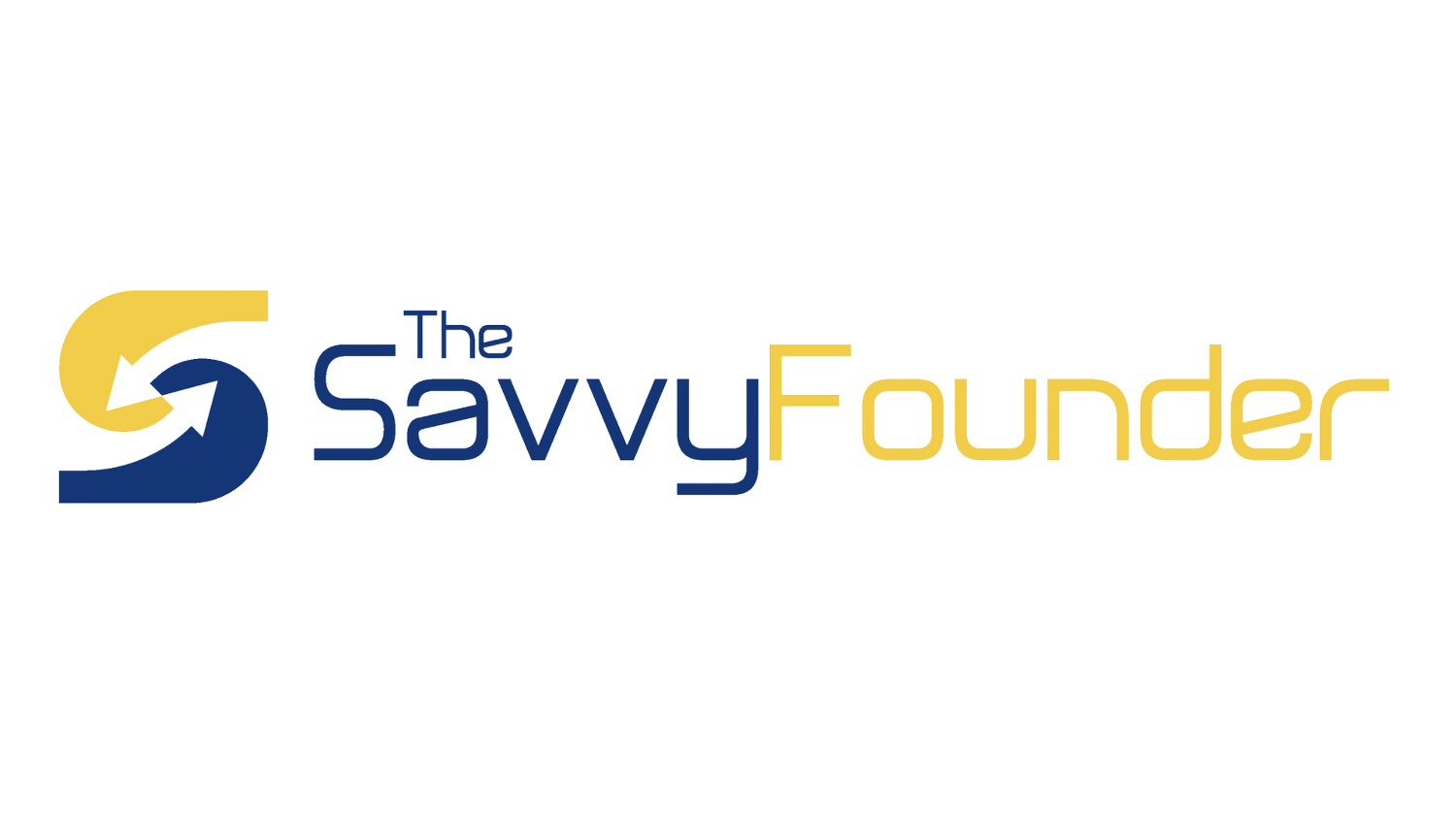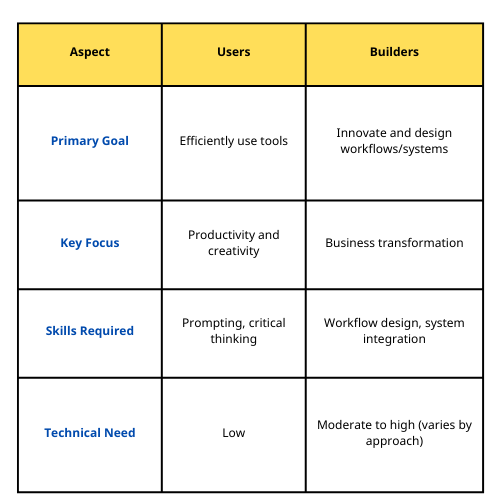The Skills You Need to Thrive with Generative AI—Whether You’re a User or Builder
As generative AI continues to reshape industries, it’s essential to distinguish between the skills required to use generative AI tools effectively and those necessary to build workflows, processes, and applications leveraging these tools. While technical expertise can supercharge AI capabilities, it’s not a prerequisite for using AI tools. Instead, understanding where you fall on the spectrum—user or builder—can guide your skill development.
AI Users: Harnessing Generative AI for Everyday Tasks
For those using generative AI tools in their current workflows, the focus is on practical application rather than technical mastery. These users employ AI to boost productivity, creativity, and efficiency across tasks such as content creation, data analysis, and customer service.
Key Skills for Generative AI Users:
Prompt Engineering: Crafting effective prompts to get desired outputs from AI tools like ChatGPT, MidJourney, or DALL·E.
Critical Thinking: Assessing the accuracy and relevance of AI outputs, particularly when integrating them into decision-making or communication.
Adaptability and Learning Agility: Staying updated on new AI tools and features to remain competitive.
Ethical Awareness: Understanding AI’s limitations, biases, and potential ethical implications to use it responsibly.
These skills don’t require a deep technical background, but they rely on understanding how to frame problems and interpret AI-generated solutions.
AI Builders: Designing New Workflows and Systems
Builders take generative AI beyond pre-packaged applications. They create new workflows, redefine business processes, and develop software solutions tailored to unique organizational needs. While some builders may not be programmers, they leverage tools like no-code/low-code platforms (e.g., MindStudio) to bridge the gap between user and developer.
Key Skills for Generative AI Builders:
Workflow Design: Mapping out processes where generative AI can replace or enhance traditional methods.
Systems Thinking: Understanding how different components (human, machine, and process) interact within an organization to maximize AI impact.
Basic Technical Proficiency: Familiarity with APIs, no-code/low-code platforms, and AI frameworks like LangChain or AutoGPT for creating customized solutions.
Project Management: Collaborating with teams to identify pain points, implement AI-driven improvements, and measure success.
Innovation and Creativity: Visualizing new applications of AI that provide a competitive edge.
Builders benefit from technical skills but often rely more on creative problem-solving, a growth mindset, and cross-functional collaboration to unlock AI’s full potential.
Distinguishing Users from Builders
The critical distinction between users and builders lies in the scope of their engagement with AI. Users focus on applying existing tools to solve problems, while builders are constructing new tools or systems to drive innovation.
Why Technical Skills Are a Bonus, Not a Requirement
While technical skills (e.g., programming, machine learning expertise) can expand the horizons of what you can achieve with AI, they’re not essential for users or even for builders leveraging no-code/low-code platforms. However, technical proficiency can:
Enhance Problem Solving: Allow builders to integrate AI more deeply into systems.
Reduce Dependencies: Enable self-sufficiency when developing AI solutions.
Increase Customization: Unlock the ability to create bespoke applications that fit unique business needs.
Building the Skills You Need
Regardless of whether you see yourself as a user or a builder, the following approaches can help you cultivate the right skills:
Learn Prompt Design: Practice creating prompts to improve AI outputs.
Develop Critical Thinking: Regularly question and refine AI-generated results.
Experiment with Tools: Explore AI platforms that align with your goals, from simple content generators to robust workflow automation tools.
Invest in Continuous Learning: Stay updated with AI trends through courses, workshops, or hands-on projects.
Collaborate Across Teams: Work with colleagues to identify opportunities where AI can drive value.
The Future of Work with Generative AI
In the age of generative AI, the greatest opportunities lie at the intersection of human creativity and machine efficiency. Whether you are a user leveraging AI tools or a builder designing transformative systems, the key is to focus on skills that enable you to collaborate with AI effectively. With these skills, you can thrive in a world where technology augments human potential rather than replaces it.
Challenges and Solutions for Users and Builders
Challenges and Solutions for Users
Users focus on leveraging generative AI tools to improve productivity, creativity, and problem-solving. Here are their common challenges and potential solutions:
Challenge 1: Understanding the Tool’s Capabilities and Limitations
Problem: Users often overestimate or underestimate what generative AI tools can do, leading to unrealistic expectations or missed opportunities.
Solution:
Provide accessible training resources (e.g., tutorials, webinars) to help users grasp the scope of AI capabilities.
Encourage users to experiment with different prompts and explore AI-generated outputs to build familiarity.
Challenge 2: Crafting Effective Prompts
Problem: Poorly written prompts yield inaccurate or unhelpful outputs, frustrating users.
Solution:
Teach prompt engineering as a skill, focusing on specificity, context, and iterative refinement.
Offer templates or examples of effective prompts for common use cases.
Challenge 3: Verifying AI-Generated Outputs
Problem: Users may rely on AI outputs without verifying their accuracy, leading to errors in decision-making.
Solution:
Train users to critically evaluate AI outputs and cross-check them with reliable sources.
Use AI tools that provide source references or citations where possible.
Challenge 4: Ethical Concerns
Problem: Users might unintentionally use AI in ways that raise ethical questions, such as plagiarism or spreading biased information.
Solution:
Incorporate ethical guidelines into training, emphasizing responsible AI use.
Encourage users to understand copyright laws and identify bias in AI-generated content.
Challenge 5: Resistance to Change
Problem: Some users may be hesitant to adopt AI tools due to fear of job displacement or a steep learning curve.
Solution:
Highlight AI as an augmentation tool, not a replacement, to alleviate fears.
Provide step-by-step guides or hands-on support to ease the learning process.
Challenges and Solutions for Builders
Builders focus on creating workflows, processes, and applications that integrate generative AI. They encounter challenges related to design, technical implementation, and collaboration.
Challenge 1: Identifying High-Impact Use Cases
Problem: Builders may struggle to determine where generative AI can deliver the most value.
Solution:
Conduct stakeholder interviews to identify pain points and opportunities for improvement.
Use tools like the Business Model Canvas to align AI initiatives with organizational goals.
Challenge 2: Lack of Technical Expertise
Problem: Builders without coding experience may feel limited in creating sophisticated solutions.
Solution:
Leverage no-code/low-code platforms to build applications without deep technical knowledge.
Collaborate with technical experts to bridge knowledge gaps while gaining hands-on experience.
Challenge 3: Integrating AI into Existing Systems
Problem: Legacy systems and siloed data can complicate AI integration efforts.
Solution:
Focus on modular AI implementations that can plug into existing workflows incrementally.
Use APIs and middleware to ensure compatibility between new AI tools and legacy systems.
Challenge 4: Managing Cross-Functional Collaboration
Problem: Builders must often collaborate with diverse teams, which can lead to misalignment or miscommunication.
Solution:
Use clear project charters and communication frameworks to align goals and expectations.
Foster a culture of collaboration by involving stakeholders early and regularly in the process.
Challenge 5: Measuring Success
Problem: Builders may find it challenging to quantify the ROI of AI initiatives.
Solution:
Define clear success metrics (e.g., time saved, revenue generated) at the outset.
Implement tracking tools to monitor AI performance and continuously improve workflows.
Challenge 6: Ethical and Legal Compliance
Problem: Builders must navigate complex ethical and regulatory considerations when deploying AI solutions.
Solution:
Conduct regular ethical reviews and involve legal teams to ensure compliance with regulations.
Design systems with transparency and accountability, such as logging AI decisions for audit purposes.
Conclusion
Both users and builders face unique challenges when working with generative AI, but these hurdles can be overcome with the right strategies, training, and support. By addressing these challenges proactively, organizations and individuals can unlock the full potential of generative AI and ensure its responsible use in their workflows and innovations.
Closing Thought
Generative AI is not just a tool; it’s a catalyst for redefining how we work. By understanding your role—whether as a user or a builder—you can better align your skillset to maximize AI’s value in your professional journey.



